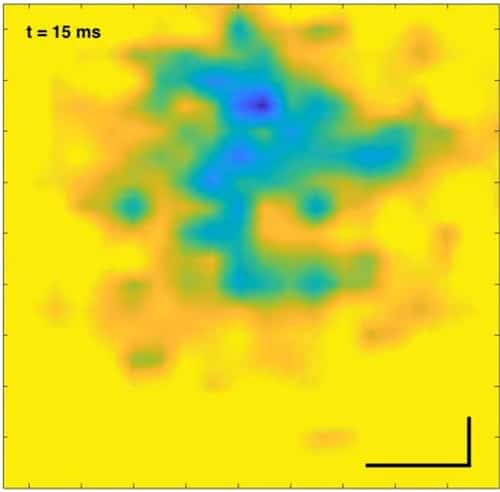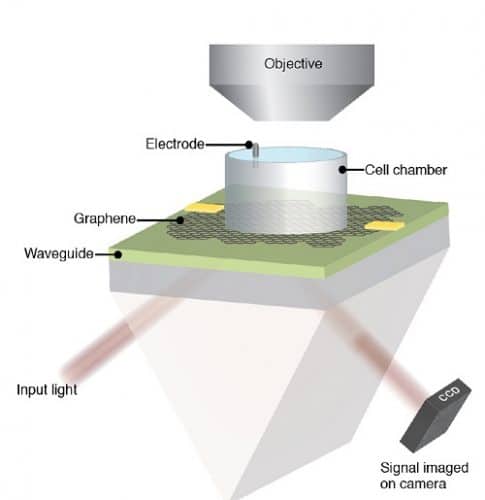Made up of graphene sheet, the device captures camera-like images of electrical signals generated by human body cells

For treating patients suffering from a certain medical condition, it is essential for medical professionals to study the generation and flow of electric signals in the human body. To date, electrodes or chemical dyes have been used to measure electrical firing in various body cells.
But a team of scientists, comprising physicists at the University of California, Berkeley managed to capture the real-time electrical activity of a beating heart — using a graphene sheet. Using it, an optical image of the faint electric fields generated by the rhythmic firing of the heart’s muscle cells was recorded — almost like a video camera. This graphene camera is a new type of sensor for studying cells and tissues that generate electrical voltages, including neuron groups or cardiac muscle cells. An amazing feature of this sensor is that while electrodes and dyes measure the voltage at only a single point, a graphene sheet measures the voltage continuously over all the tissue it touches.
“Because we are imaging all cells simultaneously onto a camera, we don’t have to scan, and we don’t have just a point measurement. We can image the entire network of cells at the same time,” said Halleh Balch, PhD recipient from UC Berkeley’s Department of Physics.

Because the graphene sensor works without labelling cells with dyes or tracers, it can be easily combined with standard microscopy to image fluorescently labelled nerve or muscle tissue while simultaneously recording the electrical signals of the cells.
The team calls the tool a critically coupled waveguide-amplified graphene electric field sensor or CAGE sensor.
Leveraging Electric Field Sensitivity Of Graphene
Due to its unique electrical properties, robustness, and optical and optoelectronic properties, graphene has captured the interest of physicists for several decades.
A few years ago, Feng Wang, UC Berkeley professor of physics, discovered that electric field affects graphene reflection or absorption of light. It became the basis for designing the graphene camera. The results of a properly tuned graphene sheet (one centimetre in length) placed on a live heart from a chicken embryo showed that electrical signals flowing along the surface of the heart during a beat changed the reflectance of the graphene sheet.
“When cells contract, they fire action potentials that generate a small electric field outside of the cell,” Balch said. “The absorption of graphene right under that cell is modified, so we see a change in the amount of light that comes back from that position on the large area of graphene.”
However, it was also found that the change in reflectance was too small to easily detect. An electric field reduces the reflectance of graphene by at most 2%; the effect was much less from changes in the electric field when the heart muscle cells fired an action potential.
Therefore, a thin waveguide was added below graphene, forcing the reflected laser light to bounce internally about 100 times before escaping, thus amplifying the signal. This allowed the reflectance detectable by a normal optical video camera. Although the increased amplification lowered the image resolution at 10 microns, it was more than enough to study cardiac cells that are several tens of microns.

Besides cell monitoring, another application is testing the efficacy of drug candidates on heart muscle before clinical trials to see whether, for example, they induce an unwanted arrhythmia. The graphene sensor could also be placed directly on the brain surface to continuously measure electrical activity — for example, to monitor neuron firing in the brains of those with epilepsy or to study fundamental brain activity. Conventional electrode arrays measure activity at a few hundred points, but not continuously over the brain surface.
“One of the things that are amazing to me about this project is that electric fields mediate chemical interactions, mediate biophysical interactions — they mediate all sorts of processes in the natural world — but we never measure them. We measure current, and we measure voltage,” Balch said. “The ability to image electric fields gives you a look at a modality that you previously had little insight into.”
“This study is just a preliminary one; we want to showcase to biologists that there is such a tool you can use, and you can do great imaging. It has fast time resolution and great electric field sensitivity,” said Jason Horng, a UC Berkeley PhD recipient and postdoctoral fellow at the National Institute of Standards and Technology. “Right now, it is just a prototype, but in the future, I think we can improve the device.”
The above collaboration was between two teams of quantum physicists at the University of California, Berkeley and physical chemists at Stanford University. The development can be read in detail in the journal Nano Letters.







